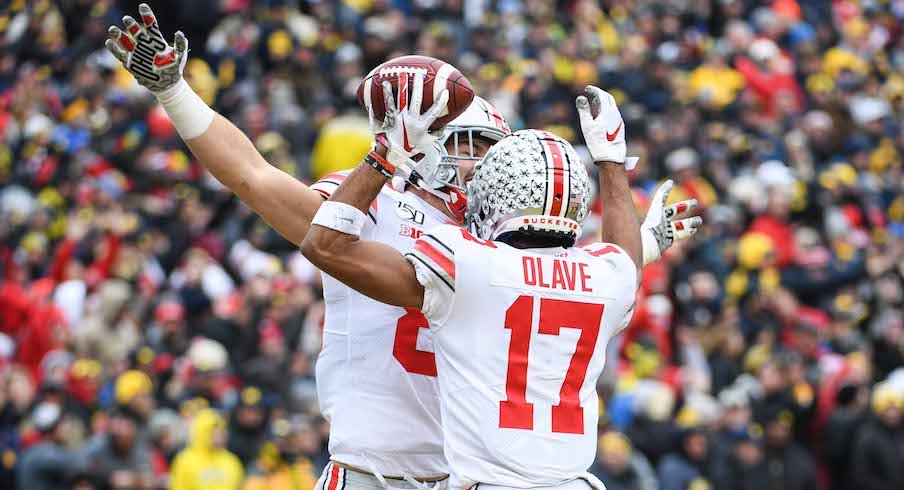Would Ohio State be stuck with the bill on canceled ‘guarantee games’?
Gene Smith began his three-decade-long career as a college athletic director at Eastern Michigan.
The stint left him with an appreciation for the effect nonconference football games have on the budgets of mid-major schools. Known as “guarantee games,” smaller schools receive a guaranteed paycheck for showing up at a blue-blood’s stadium.
Their importance has only heightened since an economic downturn has trailed the coronavirus pandemic, prompting nearly a dozen schools below the Power Five conference level to cut varsity sports teams over the past month.
“I know the dire strait that they are in,” Smith said.
It’s one reason that Smith, who has led Ohio State’s athletic department for the past 15 years, hopes his powerhouse football program will ultimately play its entire regular-season slate this fall amid the outbreak of COVID-19.
The Buckeyes have two guaranteed games on their schedule — the Sept. 5 season-opener against Bowling Green and a Sept. 19 matchup with Buffalo — that oblige them to pay out $1.2 million and $1.8 million, respectively, according to copies of the game contracts obtained by The Dispatch through a public records request.
But it’s unclear if Ohio State would still owe the two Mid-American Conference schools the combined $3 million if the games were not held, a scenario that could unfold if the season is canceled or if the number of games is reduced.
Asked about the possibility last week, Smith said he deferred to the university’s general counsel office.
Lawyers undoubtedly would wrestle with the issue if it arises. The fine print leaves room for interpretation.
An 82-word provision in the middle of the contracts spells out “force majeure,” or superior force — events that allow Ohio State to cancel a game without a financial penalty. Those include power failure, strikes, severe weather conditions, riots, war or “other unforeseen catastrophes or disasters beyond the control of either party.”
A pandemic or similar public health outbreak is not specifically mentioned.
“The question is whether the other unforeseen catastrophes or disasters could include the pandemic or government interference,” said Jeffrey Ferriell, a law professor at Capital University.
Ferriell was one of two law professors who reviewed the game contracts at the request of The Dispatch in order to offer a sense of the potential cost of a canceled home nonconference game for OSU.
The Buckeyes already stand to forfeit millions of dollars from sales of tickets, concessions and merchandise if a game is not played. But would it still be on the hook for payouts to its opponents as well?
Charlie Russo, a University of Dayton law professor, thought the pandemic was likely to be viewed as an event that was unforeseen by the schools.
The game contracts were signed several years ago, and it was not until January when the first case of the coronavirus was confirmed in the United States.
“I don’t think anybody could have expected them to anticipate COVID,” Russo said.
But without the contracts explicitly citing a pandemic as an unforeseen event, Ferrell said the provision’s language must be deciphered.
“The court is having to figure out what unmentioned things did the parties refer to or intend to be included,” he said.
The professors drew one notable distinction: It matters whose decision would prompt the game’s cancellation.
If local government regulations involving contact sports competitions or gatherings of the hundreds of people required to stage a football game remain in effect by September, Ohio State could be prohibited from hosting either game. Common law doctrine could absolve the school from damages because a game would impossible to stage in such an instance.
“It’d be illegal to play the game,” Ferriell said.
It also wouldn’t be Ohio State’s decision.
“If I were Ohio State, I think I’d hold my ground because I’m not canceling this because I want to,” Russo said. “I’m canceling it because I have to.”
But if Ohio State canceled the game in the absence of a government mandate, it might then need to rely on the force-majeure clause.
Whether a dispute ultimately could emerge also hinges on optics.
Ferriell observed that such a cancellation would pit two Ohio public universities — OSU and Bowling Green — against each other. They might be encouraged to reach an agreement.
In either case, the result would be worth watching, because in the aftermath of the pandemic, every dollar matters to athletic departments.
Entire article:
https://www.dispatch.com/sports/202...stuck-with-bill-on-canceled-guarantee-games/1






